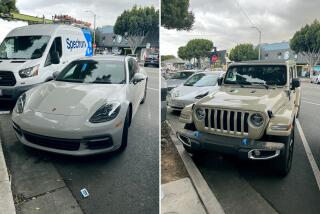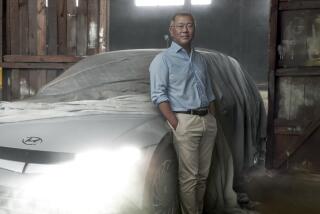Redesigned Camry, Sonata debut as competition heats up
The battle for buyers of family sedans — already the most competitive U.S. auto segment — will heat up this fall when Toyota and Hyundai launch dramatically restyled versions of their respective offerings, the Camry and the Sonata.
A decade ago, the default choices in this biggest slice of the auto market were the Camry and Honda’s Accord, but the competition has grown fierce in the last five years. Automakers can’t afford a misstep with a new model, and they can’t fall behind with a dated model.
That’s why Toyota and Hyundai debuted redesigns of their flagship sedans at the New York International Auto Show this week — even though the current version of the Camry is just 2 years old and the current Sonata launched as a 2011 model. Car companies typically wait five years between redesigns.
“The market is evolving faster, and consumer patience for vehicles that have not changed is dropping,” said Karl Brauer, an analyst with auto information company Kelley Blue Book.
The Camry has been the nation’s bestselling passenger car for a dozen years, but its lead over competitors is narrowing. Through the first three months of this year, Toyota sold about 94,000 Camrys. That leads the Nissan Altima by about 5,000 sales and the Honda Accord by about 15,000 sales.
But the Accord’s market share is growing. When commercial sales to rental car companies and other fleet customers are subtracted, the Honda actually beat the Toyota last year, Brauer said.
That has prompted Toyota to ratchet up the discounts. Through the first three months of this year, Camry sales incentives averaged just over $3,200, almost $500 more than the industry average for the mid-size sedan segment, according to ALG, a consulting firm that estimates used-car values for the leasing business. The Camry’s average transaction price was $24,039, about $800 less than the segment average, ALG said.
Although Toyota sold more than 400,000 Camrys last year — about 16% of the mid-size sedan market — consumers have requested improvements, said Bill Fay, general manager of Toyota’s U.S. sales division.
“They wanted a more emotional styling and a better interior,” Fay said.
Buyers also are looking for Toyota to continue to make improvements in ride, handling, technology and safety, he said. Often criticized for producing boring cars, Toyota challenged that notion with the Camry’s new design.
The automaker’s designers and engineers re-imagined nearly every exterior surface of the car, Fay said.
“Only the roof remains unchanged,” he said.
With its new look, Toyota’s designers worked to make the previously pedestrian Camry far more muscular.
The hood has four sculpted lines that trace back to the windshield and provide a sense that the car is in motion. Lines on each side of the Camry convey the same effect. The aggressive front bumper features a wider and more prominent trapezoidal grille shape, making the car look more securely planted on the road.
“You expect to have some sort of minor freshening at the three-year mark, where the Camry is now, but I was surprised to see such a substantial change. That has not been in the playbook for Toyota,” said Jake Fisher, automotive director of Consumer Reports. “They are feeling the competition.”
He likes the new styling and believes it will resonate with consumers.
To improve driving dynamics, Toyota bolstered the chassis and body structure with additional spot welds to improve rigidity and ride quality. It also retuned the suspension to give the Camry’s handling a sportier feel.
Toyota engineers improved the window and door seals to reduce wind and road noise. The Camry’s interior is upgraded with more soft-touch materials.
Because Toyota has led this segment for so long, other automakers “know they have to beat Camry at its own game” if they want to make inroads, said Tom Libby, an IHS Automotive analyst. “That drives incredible product redesigns and is great for the consumer.”
That’s exactly what Hyundai is doing with the redesign of its Sonata sedan.
“It feels more substantial and more luxurious,” said Brauer of Kelley Blue Book. “The look of the interior components is great. The car is really well done.”
The new version continues Hyundai’s value strategy of packing the vehicle with features and pricing it below major competitors such as the Camry and Accord, he said.
Although Hyundai studied the ride and steering of Volkswagen’s Passat sedan, its benchmark for this segment is the Accord.
The Honda “has set the segment ablaze and is leading in retail sales,” said John Shon, manager of product planning for the Sonata.
Designers wanted to give the car a premium ride quality with improved steering response and reduced cabin noise, he said.
The Hyundai sedan follows the same “Fluidic Sculpture” design language that the South Korean automaker introduced with the outgoing Sonata five years ago. But the new version has a more refined, gentler look that gives the Sonata a more stately stance. Hyundai is clearly leaning toward luxury over sport with the new look.
For shoppers looking for expressive over conservative, the automaker will offer a Sonata Sport version with a more aggressive front grille and bumper, side rocker extensions and side chrome molding.
Hyundai is packing the frame of the new model with advanced high-strength steel — a move the automaker said improves ride quality and crash test performance.
Like the previous generation, the Sonata will come equipped with only four-cylinder engines. The main power plant is a 2.4-liter four-cylinder with 185 horsepower and 178 pound-feet of torque. There’s also a 2.0-liter turbocharged engine option that produces 245 horsepower and 260 pound-feet of torque.
The automaker has redesigned the inside of the cabin to give the Sonata more room than most of its competitors. The car will qualify as a “large” vehicle rather than a mid-size sedan under the Environmental Protection Agency classification.
On the technology front, Hyundai is putting Apple’s CarPlay system into the Sonata. The system will give iPhone users access to car-safe apps on the 8-inch touch screen in the dashboard. Users of the iPhone 5 and above will be able to make calls, use maps, listen to music and access messages through their device.
Toyota and Hyundai expect their sedans will be their bestselling vehicles this year. Fay said the new version of the Camry will enable it to repeat as the nation’s top-selling passenger car for a 13th consecutive year.
“Toyota will remain under pressure to keep that car at the top of the sales chart,” Brauer said. “They will have to utilize sales incentives and fleet sales, but that is going to hurt the resale value of the Camry, which has been one of Toyota’s traditional strengths.”
Other automakers won’t sit still, said Shon, the Sonata product planner. “Everyone brings their A game into this segment.”
Twitter: @latimesjerry







